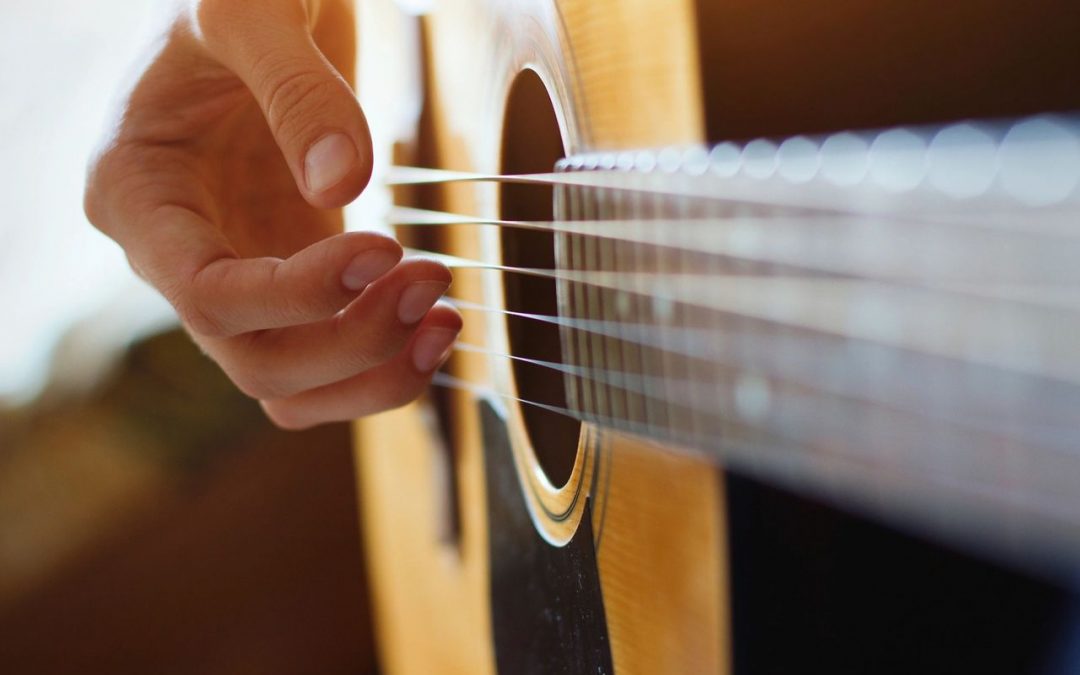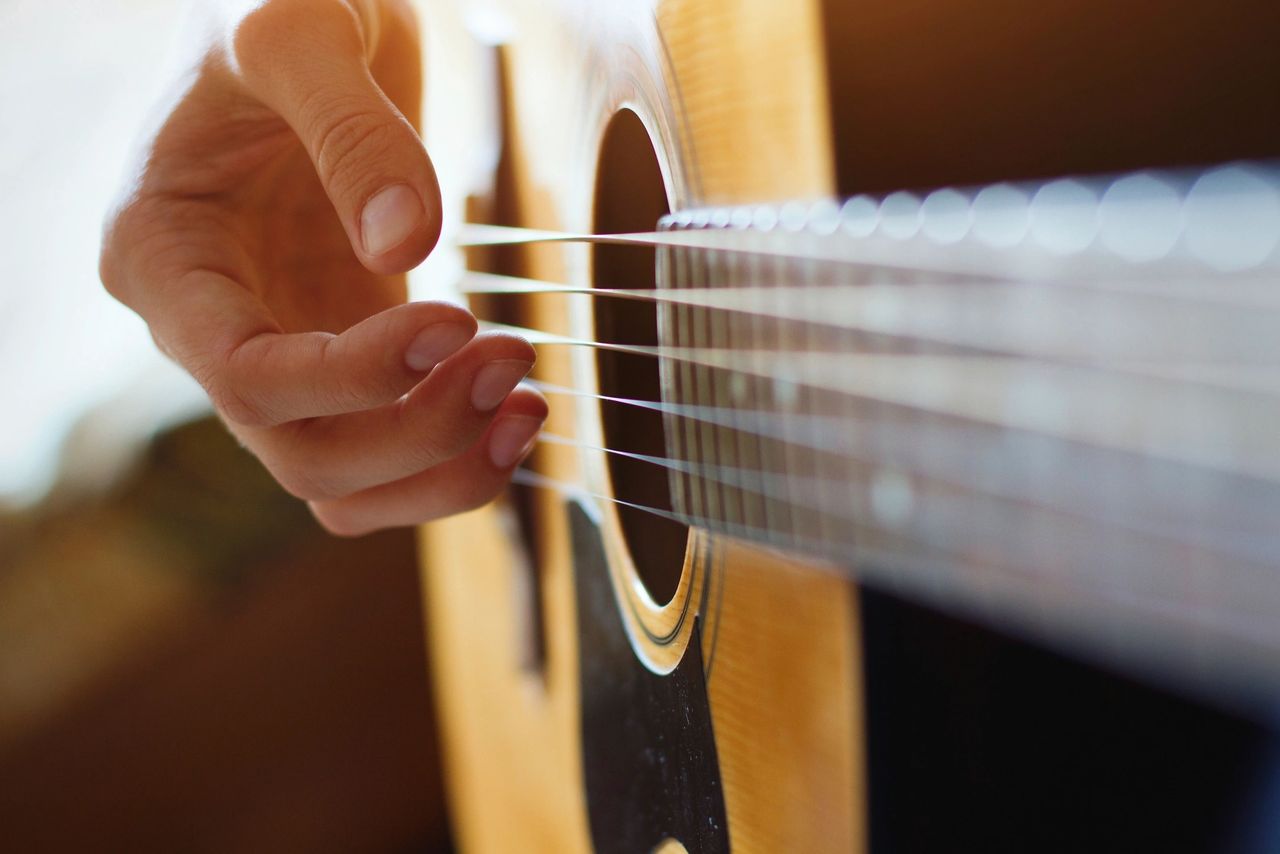
Whether you’re learning your way around the guitar or trying to figure out how to make it easier to play, you need more than a great instrument. You also need to find the best guitar neck shape for you that feels best in your hand and is comfortable to play.
There’s not a specific size or shape that makes one guitar neck better than the rest, but several aspects must be considered. This article will help explain the difference between guitar necks, shapes, and considerations to make the best choice for you. Here’s how to get started.
What Are Guitar Necks (and Why Do They Matter?)
Guitar necks make up the middle, narrow section of the guitar that you hold when you play chords. Here’s a breakdown of the different neck parts and how they connect to your guitar:
Headstock
The guitar headstock is located at the top of your guitar and holds the tuning pegs. Each peg, or key, turns to tune the strings of your guitar. Some musicians call the headstock the “pegstock” of the guitar. Headstocks can come in different shapes and sizes, straight or angled.
Nut
Nuts are essential to making sure a guitar plays properly, despite its small size. The guitar neck is located directly below the headstock and is a vital but often overlooked part of the guitar. It’s a small piece of plastic or other hard synthetic material that helps keep the string in line.
Frets
A guitar fret is made from metal wire or another thin strip of material and starts just below the nut. The number of frets on a guitar usually varies depending on the brand and model. Acoustic guitars typically have 18 to 20 frets, and electric guitars have 22 to 24.
Fretboard
The guitar fretboard is a long strip of wood or other material that sticks out from the body of your guitar. The guitar strings will stretch over the fretboard from the headstock to the bridge on the guitar’s body.
Body
The body of a guitar consists of the sound box of an acoustic guitar or the pickup combination of an electric guitar. The sound hole area is also where the neck of your guitar stops.
Types of Guitar Necks
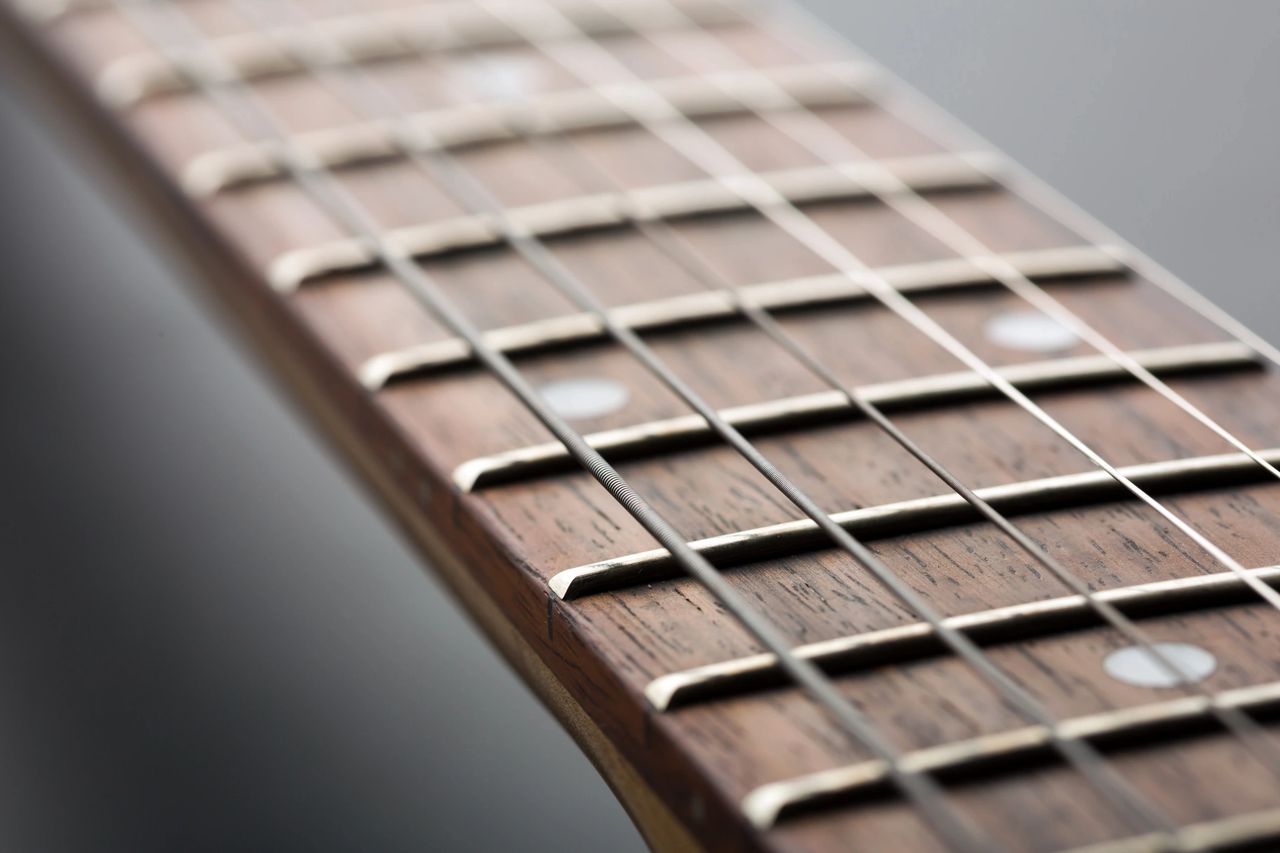
Now that you know the ins and outs of the neck and how it works, get to know the different sizes and shapes.
C-Profile Guitar Neck
C-profile guitar necks are the classic shape you’ll find on most guitar models. They’re usually round and comfortable for most people to hold. Most guitar players with smaller hands also gravitate towards C-necks with narrow fretboards and less width.
Despite their reputation for comfort, players with larger hands usually prefer bigger and deeper neck profiles. C-profiles are also considered asymmetrical necks.
V-Profile Guitar Neck
V-profile guitar necks are shaped wider at the nut and then get increasingly narrow as they approach the guitar’s body. V-profiles are well suited for players who rest their thumbs on the back of their guitar or over the top of it.
V-necks are often seen on vintage guitars and have a rarer profile on modern guitars. Like C-shaped necks, the V-profile is also asymmetrical in shape.
U-Profile Guitar Neck
U-shapes are suitable for players with large hands who are more comfortable resting their thumb on the back or side of the neck. U-neck shapes are wider, and their neck gets thicker as they meet up with the body of the guitar to create a “U” shape. U-necks also have a rounded shape with less of a curve around their shoulder area and are sometimes called “baseball necks.”
D-Profile Guitar Neck
D-profile necks are similar to a “U” shape but start to narrow towards the heel. It’s a common neck profile for electric guitars, jazz guitars, and fingerstyle players with larger hands who want to rest their thumbs on the side of the neck or behind it. D-shape necks are also referred to as the modern flat oval guitar neck.
Does the Neck Shape Change the Sound of a Guitar?
You shouldn’t notice a difference in sound from the neck profile alone. However, the neck can change the feel of how you hold and play the guitar. If you’re uncomfortable playing, it can impact the sound of your performance. Or, if you choose a thin neck that’s known for fast playability, it will also impact the sound.
However, the neck wood could affect the tone by influencing the way the vibrations sound based on how the strings interact with the neck. When you use dense neck wood, like a map, you might get a brighter sound. For example, mahogany could produce a resonant, warmer tone.
Guitar Neck Widths
The neck’s profile shape isn’t the only thing that impacts the playability of your guitar. The width of your guitar neck is suited for different hand sizes and playing styles.
Most players with smaller hands choose neck profiles that are shallow and thinner. Thin necks are also well-suited for metal and jazz genres because you can quickly slide your hands up and down the fretboard. Beyond the size of your hands, if you have pain or experience arthritis, you’ll probably find a thinner neck easier to play.
Players with larger hands usually go for U- or V-neck profiles that prove wider at the base. Thicker necks are also ideal for rhythmic musical styles because they help support your hand so you can relax and navigate the cords.
Pros and Cons of Thin Guitar Necks
Thin guitar necks are usually easier to play for musicians with smaller hands or who prefer a lower action. A thin neck profile allows more flexibility to find a comfortable and accurate finger movement to master those intricate solos or chords.
However, thin guitar necks aren’t for everyone. They’re not always comfortable for people with large hands, and you may find them challenging to adapt to if you’re already playing on a thicker profile. Some players also report that thin necks have less vibration transferred to the body of the guitar, which negatively impacts the sound they want.
Pros and Cons of Thick Guitar Necks
For some players, thick guitars are more comfortable to play, especially if you have larger hands or prefer a higher action. They’re also usually the better neck profile for heavy strumming or if you want to hear a more resounding vibration from the guitar body.
The downsides are that thick necks are difficult for smaller hands or lower actions and can sometimes make it difficult to move fingers accurately and comfortably. A thicker profile may also prove challenging to move up and down the neck, depending on your hands and personal preferences.
Guitar Neck and Its Fretboard Radius
The radius of a guitar neck fretboard refers to the curvature of the surface of the fretboard. It’s usually measured in inches and is most commonly found in a range of 9.5″ to 16″ on electric and acoustic guitars.
A smaller radius will result in a flatter fretboard, while a larger radius will result in a more curved fretboard. The radius is important because it can affect the playing feel and the ability to perform certain techniques, including string bending. Some guitar players prefer a flatter radius for easier chord work, while others prefer a more curved radius for lead playing.
A guitar’s neck profile and the radius of the fretboard can also work together to affect the playing feel of the guitar. For example, a C-shaped neck with a flatter radius (9.5″) may be more comfortable for chord work, while a V-shaped neck with a more curved radius (14″) may be more suitable for lead playing and string bending. Some guitar manufacturers will offer different options for neck profile and fretboard radius, so players can choose the one that fits their playing style and preferences.
Fret Size
The fret size of a guitar neck impacts how it feels when you play it. When someone talks about the radius of a guitar neck’s fretboard, it refers to the curvature of the fingerboard across its width. The radius is measured from the center of the fingerboard to the outer edge. It also varies depending on the guitar and brand.
When you choose a guitar with a smaller radius, such as 7.25 inches, it usually has a curved fingerboard. The larger the radius, such as 12 inches, the flatter the fingerboard. Smaller radiuses often feel more comfortable for players moving their fingers across the fingerboard. A larger radius can also make it easier, particularly for single-note runs and bending strings.
You’ll also need to consider a compound radius fretboard with a different radius across the guitar. It usually starts with a smaller radius near the nut and gradually increases to something larger near the body of the guitar. Players may feel it’s easier to master their chording near the nut and bend strings near the body of the guitar.
Depending on your playing style, the fretboard’s radius is a personal preference, and some players may prefer a flatter or more curved fingerboard. Many guitar manufacturers also offer different radius options on their models, so you may need to try out a few to find the one that feels best in your hands.
Nut Width
The nut width of a guitar indicates the distance between the outer edges of the nut and is measured at the widest point. Those points are usually seated between the low E and high E strings. The nut width can change how it feels and sounds, especially depending on your hand size.
Like anything else with a guitar, the nut width is a personal preference. A narrow nut width is usually around 1.65 inches (42mm). It’s more commonly found on classical and acoustic guitars to make it easier to play fingerstyle techniques, including tremolo and arpeggio. Wider nuts, around 1.68 inches (42.67mm), are more commonly found on electric guitars to make it easier to play with a pick and perform complex chord work.
What Is a Set Neck?
A set-neck is how the neck and body of a guitar are joined and glued into place. The neck joint is cut to match the mounting area and connected with dovetail joints. The goal is to keep the neck from moving, or at least minimize any movement. Some electric guitars also come with a set neck, including Gibson’s Les Paul model.
What Is a Bolt-On Neck?
Unlike set necks that use glue, bolt-on necks join a guitar neck with screws and bolts. Whether or not a neck is glued or bolted can also impact how you play it and the type of tone produced.
You’ll get a warmer and fuller sound on a set neck guitar that sustains. On the downside, a set-neck guitar is difficult, if not impossible, to repair and reset. Bolt-on necks usually have a snappy, twangy tone, often seen in Fender guitars. They’re also easier to manufacture and more straightforward to fix if there are any issues.
What is a Fast Neck?
A fast guitar neck is designed to make it easier to play fast songs as quickly and seamlessly as possible. The necks are usually thinner and flat to help players fingers glide easily to the frets.
Which Guitars Have Thin Neck Profiles?
If you’ve decided a thin neck profile is the right choice for you, you’ll need a guitar to match. However, many guitar brands offer both thin and thick neck profiles. If you’re already a fan of a specific brand, you can probably find a neck profile that suits your needs.
Here’s a roundup of some of the more popular brands to choose from.
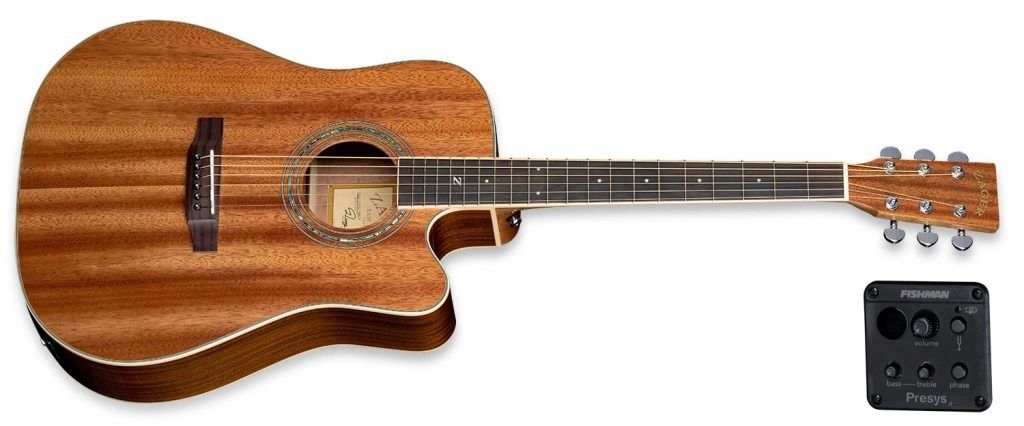
Zager Guitars
Zager Guitars is known for its acoustic models designed with ease of playing in mind. Zager earned a reputation as an easy-to-play guitar and a favorite beginner guitar that scales up to professional levels.
The neck profiles of Zager Guitars feel slim front-to-back and fit naturally in your hands, especially if you have smaller hands. Beyond the neck profiles, you’ll also find custom string spacing to help reduce buzzing and other noise while playing. Zgaer has an unusual neck that works a little differently than most. They put together a guitar neck video to help explain what to expect and how they feel.
Here are some of Zager Guitars’ easiest models to play.
ZAD 900 Series
The Easy Play Zad 900 features solid spruce and rosewood. This model is regarded as a high-end line of guitars designed for professional and serious amateur musicians. Like all Zager Guitars, you get a lifetime warranty and free, two-way shipping.
ZAD 80 Series
Zager’s ZAD 80 Series are made with handmade solid wood tops and a unique bracing system to help enhance the guitar’s tone and projection. Although it’s high-quality, it’s still a reliable entry-level guitar option for beginner to intermediate musicians.
ZAD 50 Series
If you’re looking for a smaller guitar, the ZAD 50 Series features a detailed ivory zipper stripe binding and an electronic system for a truly unique guitar. This model is often compared to the Martin D18 and Taylor 5 series, but has easier playability and a more affordable price point.
ZAD 20 Series
The ZAD 20 Series is a no-frills guitar that goes head-to-head with premium models on the market. With easier playability, this model is said to outperform $1,500 models from the big guitar brands but at a fraction of the price.
Fender Guitars
The guitar brand’s name is iconic, but it’s not always known for its playability and ease. Fender Guitars offers solid-body, acoustic, electric, and bass guitars that have become a music industry staple. They are known for a bright, punchy sound, and their electric guitar options feature single coil pickups.
Fender Acoustasonic Player Telecaster
The Fender Acoustasonic Player Telecaster features two pickup systems, a blend knob, and a mahogany back for a unique acoustic-electric playing experience. The neck profile is thin, making it an ideal acoustic guitar for beginners or anyone looking for easier playability.
Fender Newporter Player
The Fender Newporter Player features a solid spruce top with mahogany back and sides. With a creative and unique look, this guitar features a slim-taper C-shape profile and optimized bracing for a fuller resonance.
Taylor Guitars
Taylor Guitars is famous for its modern, crisp, bright, and articulate sound. They produce a line of high-quality acoustic and electric guitars and often use innovative materials and construction techniques, such as their patented bracing systems and sustainable woods. Their entry-level to professional guitars include the Grand Auditorium, Dreadnought, and Grand Symphony, among others.
Taylor 814ce Acoustic-Electric Guitar
With a thin, narrow neck, the Taylor 814ce Acoustic-Electric Guitar provides fluid and relaxed motion while playing. You can pick it up for strumming, playing jazz, or fingerpicking for virtually effortless playability. Plug it in and amplify it during a performance to maximize its sound for flawless pickups and sound.
Taylor 614ce V-Class Grand Auditorium Acoustic-Electric Guitar
The Taylor 614ce V-Class Grand Auditorium Acoustic-Electric Guitar boasts a Sitka spruce top and maple for a bright, projecting tone. It’s a great pick for performers or recreational players and comes with V-class bracing for volume boosting without compromising the tone. Like most Taylor Guitars, this model also comes with a thin neck for comfort and ease of playing.
Taylor 414ce-R Acoustic-Electric Guitar
The Taylor 414ce-R features a Grand Auditorium body shape with a versatile sound and comfortable playability and is suitable for various playing styles. With a Sitka spruce top and Indian rosewood back and sides, the tonal qualities of this model are solid, with a high-quality pickup and preamp system. You get a versatile, classic guitar with a signature Taylor neck that runs thinner than other brands.
Martin Guitars
Martin Guitars is currently the world’s oldest guitar brand, stretching back over 180 years. With premium tonewoods, Martin uses Sitka spruce and East Indian rosewood for a warm and powerful projection. Musicians choose from shapes, including the Dreadnought, Grand Auditorium, and Orchestra Model, for a quality, durable guitar that’s been used by some of the world’s greatest musicians.
Martin LX1 Little Martin
The compact, travel-sized Martin LX1 Little Martin is a smaller, more portable version of the company’s popular X Series models. It was constructed for a lightweight feel with a Sitka spruce top and mahogany high-pressure laminate (HPL) back and sides for a balanced, clear tone. This model also features a modified low-oval neck profile designed for comfortable playability, even if you have smaller hands.
Martin D-X2E
The Martin D-X2E is an acoustic-electric guitar model and part of the X Series. With a dreadnought body shape, this model offers powerful projection and a rich, balanced tone with a solid Sitka spruce top and high-pressure laminate (HPL) back and sides. The D-X2E features a modified low-oval neck profile to make it easy to play.
Martin 000-12E
The Martin 000-12E is an acoustic-electric guitar that’s smaller than a dreadnought and offers more comfort and ease of playing. With a balanced and versatile sound, this Martin guitar features a Sitka spruce top, mahogany back, and sides with a modified low-oval neck profile. With a Fishman Matrix VT Enhance electronics package, you can amplify the sound without compromising its natural and realistic tone.
Which Guitars Have Thick Neck Profiles?
If you have larger hands or prefer a thick neck profile, there are several guitars to choose from. As we said before, some guitar brands offer both thin and thick neck profiles, which often comes down to preference. It’s also possible to buy guitars with thin, wide necks or thick and narrow necks. What one person feels is too wide may work fine for another musician. Here are some thick necks to consider in your guitar search.
Cordoba Guitars
Cordoba Guitars are known for their traditional Spanish construction and design and often include a thicker neck profile. The thicker neck is designed to provide more stability and support for the left hand while playing and to keep greater tension on the strings to produce a louder and more resonant sound.
Cordoba C10
The classic Cordoba C10 offers traditional Spanish construction with a solid Canadian cedar top and Indian rosewood back and sides. The thicker neck is made of Spanish cedar with a traditional Spanish fan bracing pattern. The fingerboard and bridge are also made of Indian rosewood. Players who want more support for their left hand while playing and great tension across the strings will enjoy the thicker neck profile of the C10.
Cordoba C12
The high-end Cordoba C12 offers the signature Cordoba construction and boasts a solid European spruce top and Indian rosewood back and sides. With a thicker neck profile, the fingerboard and bridge are made of Indian rosewood, creating a louder and more resonant sound. With a natural matte finish and Cordoba’s Pro-Arte strings, the C12 is an ideal choice for classical guitarists who enjoy the stability the thick neck provides.
Santa Cruz Guitars
Santa Cruz Guitars is a high-end, hand-crafted guitar brand based in its namesake, California city. With a wide range of acoustic models and a small line of electric and bass guitars, Santa Cruz guitars are particularly well-suited for fingerstyle playing and produce a rich, warm tone with excellent projection. Santa Cruz guitars are also known for their thick necks, which are designed to provide a comfortable and stable grip for the left hand, especially for larger hands.
Santa Cruz D
The dreadnought-style Santa Cruz D is known for its powerful, balanced tone and thick neck profile to help stabilize your hand. This model features a Sitka spruce top, Indian rosewood back and sides, a fingerboard, and a bridge. The Santa Cruz D features a gloss finish and comes with Gotoh tuning machines that are well-suited for fingerstyle playing.
Santa Cruz J
The jumbo-style Santa Cruz J offers a thick neck profile and everything you want from this guitar brand, including a solid Sitka spruce top and Indian rosewood back and sides. Players with larger hands will feel comfortable mastering this guitar and will feel right at home with its powerful sound.
Santa Cruz OM
The Santa Cruz OM (Orchestra Model) is known for its balanced, versatile tone and thick neck profile. It should feel easy to grip and comfortable while playing. This model is ideal if you’re looking for more projection and a little more bass out of your guitar.
Seagull Guitars
Founded in 1982 in Quebec, Robert Godin started Seagull Guitars with a focus on affordable craftsmanship. Although there aren’t many series of Seagull Guitars on the market, some feature wider, thicker necks than others. Here are a few to consider.
The Seagull S6
The Seagull S6 includes a wide neck and odd headstock shape, but with all the craftsmanship you want from a Seagull.. You may notice a lighter X bracing for a clear, resounding tone.
Seagull Entourage Autumn Burst Acoustic Guitar
The Seagull Entourage Autumn Burst Acoustic Guitar features a smooth tone and curved top that allows for more projection. With a wide D neck profile, players with larger hands will feel right at home with this eye-catching acoustic guitar.
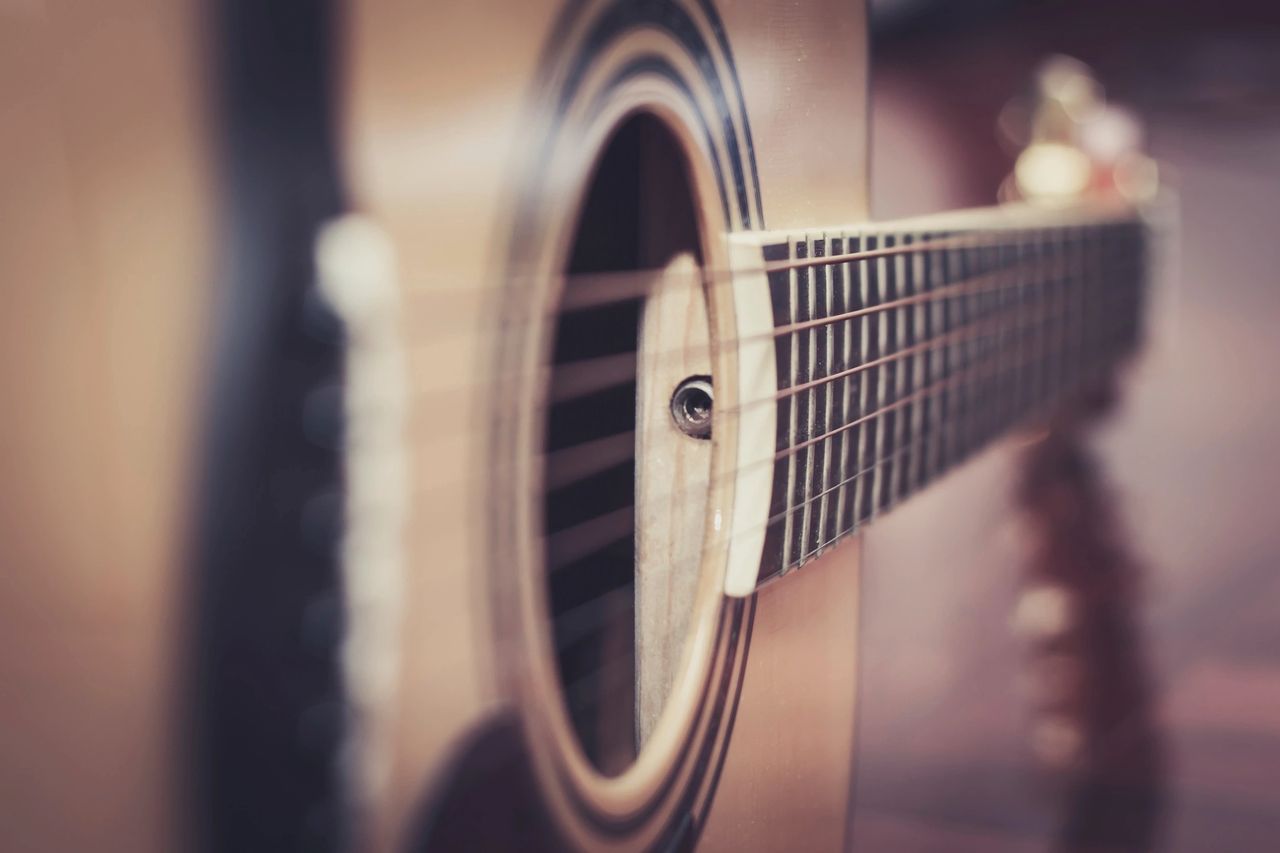
Should You Choose a Guitar with a Thin or Thick Neck?
The thin vs. thick guitar neck debate is often polarizing, but it can mean different things depending on who you ask. For example, Jackson Guitar necks run very thin, but they’re also wide, and even a few millimeters difference could feel different in your hands. Many brands also create various guitar necks to suit your needs, so a brand known for a thin neck may also produce a worthy thick neck profile. When talking about guitars, some people also mean ‘wide’ neck instead of thick or ‘narrow’ instead of thin.
Instead, approach the question of thin vs. thick with what you’re trying to accomplish with your guitar playing. Do you have small hands and hear that thin necks are more comfortable? Go with a thin neck from a guitar brand known for its ease of playability, like Zager Guitars.
Do you want to master the guitar’s technical details or have wider hands or fingers? You may need a thick guitar, and you could choose a classical acoustic from a company like Cordoba. Many companies known for their thin necks also create thick options, so you can also look into what your favorite brands offer.
The type of music you want to play also matters to which guitar neck you choose. Thicker neck profiles are often better suited for electric guitars and shredding. Thin neck profiles are often better suited for acoustic guitars.
Best Guitar Neck Winner: Zager Guitars
Plenty of guitar brands offer high-quality neck construction and placement, but not all take a customized approach. Zager Guitars‘ necks are unique and carefully crafted to consider comfort, playability, sound, and quality construction. They’re more interested in what feels good to play while sounding fantastic than providing the most iconic-looking neck or doing what every other guitar brand is producing. Whether you’re a beginner or a pro, you can pick up a Zager Guitar and start playing right away. They’re even well-suited for small hands or anyone experiencing the pain and discomfort that come with ailments like arthritis.
Final Thoughts
There’s no right or wrong answer to if you should choose a thin or thick guitar neck profile. Overall, the thickness of the guitar neck is a personal preference, and what feels comfortable to one player may not be as comfortable to another. It’s essential to try out different neck profiles to find the one that feels best for you.
Focus on what’s easiest for you to play and pay attention to how the guitar feels in your hands, how fast you can play it, and if you enjoy how it sounds. At the end of the day, mastering the guitar is a personal journey that requires experimenting and drilling down to your preferences to figure out the best choice for you.
